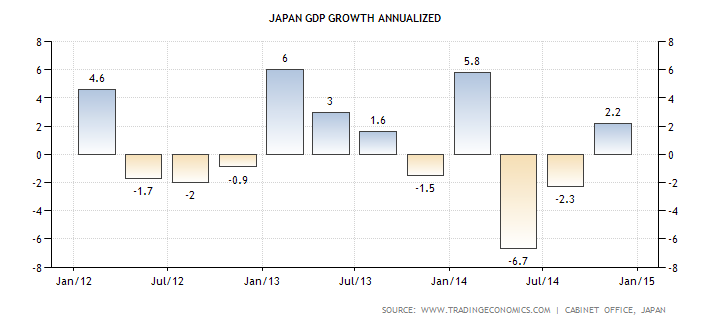Japan managed to pull out of recession in the last quarter of last year, but it was a far from convincing rebound – for Australia it means our two biggest export markets (including China) are not enjoying solid growth at the moment and won’t be for much of 2015.
December quarter GDP rose 0.6% from the September quarter (which saw the fall of 0.5% revised down to a 0.6% slump).
That was an annual rate of 2.2% by the misleading US way of measuring economic growth. It was much less than market forecasts for a 0.9% advance in GDP from the September quarter and an annual rate of up to 3.7% – in other words the first reading fell short.
Investors in the Japanese stockmarket ignored the news and sent the Nikkei, the key market indicator, to an eight year high.
The Nikkei climbed half a per cent, or 92 points, to 18,0005 points. That pushed the gains so far this year to 4.1% (in US dollars) and 3.2% in yen).
Japan limps out of recession

Now it has to be remembered that the first estimate in Japan is usually the most ‘rubbery’ and later updates find more information about trade and business investment and the estimates change, sometimes dramatically.
But even taking that into account, there wasn’t much good news in the report – it was more a stagger than one with a solid underpinning as demand especially struggles to recover from the lift in the sales tax from 5% to 8% last April 1.
Details in the report yesterday show private consumption grew by just 0.3 of a percentage point in the quarter, while business spending rose by only 0.1 percentage point. Both missed estimates, which were 0.8 and 1 percentage point.
Private consumption remains 4% lower than a year ago, thanks to the impact of the sales tax rise. And the contribution from housing fell by another 1.2% over the September quarter, after big falls in the second and third quarter.
Even net exports, which were helped by falling oil prices and a weaker yen, grew by only 0.2 percentage points. That was because while exports rose 2.7%, imports jumped by 1.3%. That underlines a big worry about the current strategy from the Bank of Japan and the Government which calls for a big boost in exports to take advantage of the weaker yen.
In fact it shows how Japan’s trade account has become less sensitive to the lower yen.
The Financial Times reported “The weakness in domestic demand supports our view that output will essentially be flat this year,” said Marcel Thieliant at Capital Economics. He adds:
"Domestic demand is set to remain weak. Apart from a temporary boost from winter bonuses, wages are barely growing. Even if the ongoing spring wage negotiations result in a strong rise in base pay, households may use more of these savings than usual to replenish savings. We therefore stick to our view that GDP will only expand by 0.1% this year.”
If that’s the case it will mean the economy is stalling.
Later this week we get the January Japanese trade balance data.
Exports are expected to have grown 13.5% from a year ago, while imports could fall by up to 5% because of weakening energy prices (offset by the weaker yen).
Data late last month for December showed a mixed view of the economy, but the major concern remains the still slowing rate of inflation.
Japanese consumer price inflation is running at a headline rate of 2.4% – a 14 month low – it has fallen from a high of 3.7% in May of last year (boosted by the sales tax boost on April 1). But core inflation is running at around 0.7%, once the impact of food and energy prices are stripped out.
Falling prices for energy imports is adding to the deflationary pressures in the economy, even though the weaker yen is mitigating the full extent of those falls. That impact will be clearer with the trade data, expected out on Friday.













